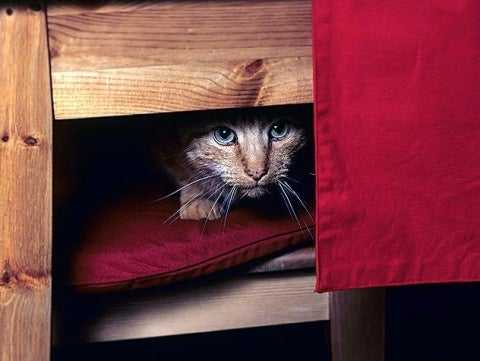How To Improve Your Cat or Kitten’s Socialization

A cat’s personality is largely formulated in the first eight weeks of life. Leaving health issues to the veterinarian, here’s what you can do to help your foster kittens be all that they can be behavioral.
Your first important task is to provide proper nutrition. Since a mother cat can lose weight while nursing, allow them to bulk up before giving birth. Some foster homes switch their pregnant foster cats back to kitten food to get those extra calories per mouthful. Studies have shown that a malnourished cat is more irritable with their kittens and provides less mothering. Consequently, their kittens will be developmentally delayed, slower to open their eyes, walk and engage in play. As they mature, such kittens show poorer learning ability, greater levels of fear and aggression, and more anti-social behavior toward other cats.
No Place like Home
When setting up a foster kitten nursery, avoid the empty room/sterile box set-up, especially for kittens two to eight weeks of age. Kittens kept in a more complex environment for their first two months are less nervous later in life than those kept in un-stimulating surroundings. Provide plenty of sensory stimulation. A radio or television can be left on in the room some of the time. Flooring can consist of newspapers, old towels, a carpet square, linoleum tile, perhaps even a piece of Astroturf™. A small cardboard box for the kittens to crawl on with a hole cut in the side can serve as a den once the kittens are mobile. Don’t use fresh produce boxes, though, for they may have been sprayed with harsh pesticides.
Engage in gentle handling as soon as possible. Early human handling results in precocious development. When the kittens are two to three weeks of age, increase the sphere of handlers to include three or four people daily to help the kittens learn to trust all humans. However, keep adult male cats out of the nursery, as the queen will perceive them as predators and will be stressed unduly.
A Family Affair
Since kittens learn by watching how an adult cat operates, it is important to keep the litter with the mother until at least eight weeks of age, which coincides nicely with the end of weaning for most kittens. Through observational learning, they get the hang of using the litter box and whether or not to cover waste, how to hunt (although this behavior is partially predetermined genetically), what foods are safe to eat and who is appropriate as a friend. Kittens also learn to cope with stress and frustration, since Mom Cat controls the “milk bar” and they don’t always get the opportunity to feed until satiated. Lastly, it is important to keep littermates together until eight to ten weeks of age. Through their interactive play, kittens learn to control their clawing and biting and to extend their acceptance of littermates to felines outside of the family.
Hand-raised single orphans or those separated from their mothers before eight weeks often prove to be hyperactive kittens who cannot handle frustration. As adults, they have a tendency to be fearful and aggressive toward people and other cats. They learn less well and have a predilection toward an asthma-like respiratory condition. Often orphans can be spared this fate by adding them to another litter or at least fostering them in a home with other cats to serve as role models.
These guidelines for optimal cat socialization and development could just make generalizations such as “aloof,” “anti-social” and “scaredy-cat” no longer applicable to America’s most popular pet.

Improving Socialization
Felines are formal creatures. Many of us impose on them in a very intimate manner before being properly introduced. We scoop them up, hug them and then feel hurt if they struggle to get down. We try again, and they rake their claws across us, leap away and dash under the sofa.
Fleeing for the safety of the nearest piece of furniture when company comes may be an indicator that your cat is undersocialized. This behavior is expected of ferals and strays, but pet cats can act similarly. At five weeks, kittens begin socializing — getting to know and live with both humans and other cats — with open paws and minds; they keep this “door of opportunity” open until they’re about three months old. If they are older than a year and newly re-homed, the door may be closed, or even locked. With a feral cat, the door may be bolted; but there is still a door!
In order to know how to socialize a kitten, it should all be based on one principle: Reinforce social behavior; ignore asocial behavior. You can’t force or punish a cat into being social. Forget your emotions and the cat’s history; instead, focus on the animal’s behavior.
A Cattery Will Get You Everywhere
The easiest method of socializing from the cat’s point of view (but emotionally hardest for humans) employs a cattery cage. Cats, like humans, learn by watching. If they can view their world without the world intruding on their space, they will socialize much faster.
- Place the cattery in a room with moderate day traffic. If the animal is very stressed, use a quiet bedroom.
- Place a covered cat bed, or a cardboard box with a hole cut for a door, in the cattery along with a small litter pan. If there is no room for a bed, drape half the cage so the cat can hide.
- Place the cat’s water opposite the litter pan. Feed them at regular intervals, at least three times a day. Leave the food in the cage for fifteen minutes, and then remove any leftovers. Don’t talk to or pet the cat during these exchanges.
- Go about your day as usual, but ignore the cat — you want them to watch you, not the other way around. Talk to yourself if you live alone; this acclimates them to a relaxed voice.
Begin “cat-enticing behaviors” in front of the cattery. Read the newspaper on the floor, underlining as you go. Sort and fold socks; play solitaire; do crosswords. Be creative, but keep the activities low-key.
From Hand to Paw
Once the cat is comfortable eating, begin to “accidentally” leave your hand a few feet from the dish. Gradually move it closer with each feeding, until the cat eats with your hand nearby. Next, place your hand in the cattery before you put in food. The cat may very well begin welcoming you by rubbing your hand!
Next, put a small amount of tasty food such as tuna oil or anchovy paste on your hand; place it near the cat in a relaxed manner. If they start to lick you, you have successfully initiated mutual grooming! Hum your praise quietly; refrain from loud outbursts such as “GOOD KITTY!”
When your cat consistently comes to your hand for a treat, put your hand in without the treat. If they come, reward them with a bit of deli turkey or freeze-dried liver from your other hand. Once your cat is comfortable taking treats from you in the cattery, it’s time to open the cage door. Make sure the door to the room is closed. The idea is to give them one room at a time.
Now try those “cat-enticing behaviors” with the cattery door open with treats scattered close to your body. If the cat initiates contact, reciprocate! You’re on your way to having a social kitty.
The key to any socialization program is patience. You can do this without a cage, but it will take longer. The most important factor is to reward and reinforce any social behaviors in a way cats understand — with food.

Introducing to Friends, Family & Other Pets
It’s best if your kitten interacts with a variety of people so they don’t only feel comfortable with one person. This is also a great time to expose your kitten to other pets, as long as those pets are gentle. Once your cat has received proper vaccinations and your vet says it’s ok to do so, invite friends and family over to meet your kitten, and if they have cat-friendly pets, invite them to tag along, too.
For adult cats, try introducing new things to keep their curiosity piqued while staying safe. New toys, treats, and smells, like autumn leaves brought inside or even your guests themselves, can help provide socialization.
Whether you have a kitten or an adult cat, it’s important to make social interactions with other people and pets as positive as possible. If your cat is comfortable and there is no risk of accidentally escaping, try to keep your cat in the room with you and your guests. Provide hiding places, such as a box or under a couch, and places where they can observe without interacting, like a windowsill or high shelf. If possible, limit the first houseguests your cat meets to a small, quiet gathering. Ask your guests not to approach your cat until they seem comfortable with their presence. At that time, they can give your cat a treat and pet them gently. If they show any signs of stress, leave them alone to retreat to a safe place.
Cats can also learn to enjoy the company of other cats. Again, the earlier and more often they are exposed to other cats, the more likely they’ll be friendly with each other. However, cats like having their personal space, too. Who doesn’t? If you have multiple cats, give them plenty of comfortable places to nap, climb and perch by windows, so they don’t compete over territory. If disputes arise at mealtimes, you may need to feed them in separate rooms. Cats can also get jealous, so be sure to give each cat one-on-one attention and playtime.
Getting your cat to embrace their social side may take time and patience, especially if they’re an adult. Remember not to force it. Give them time and space, and reward social behavior with treats. Your cat will eventually open up and show everyone the personality you’ve already grown to love.